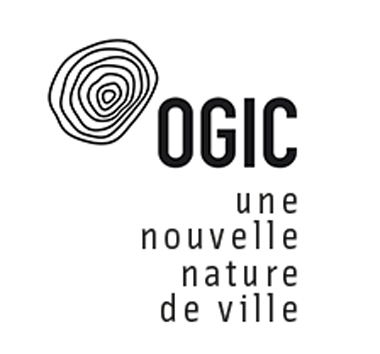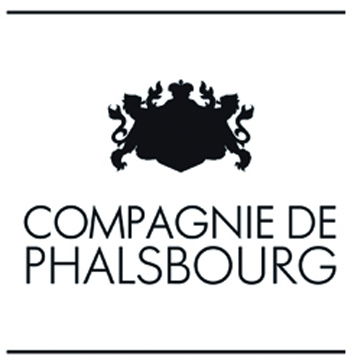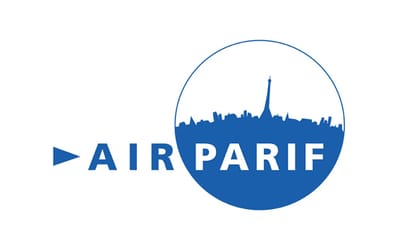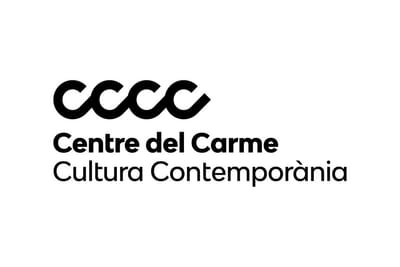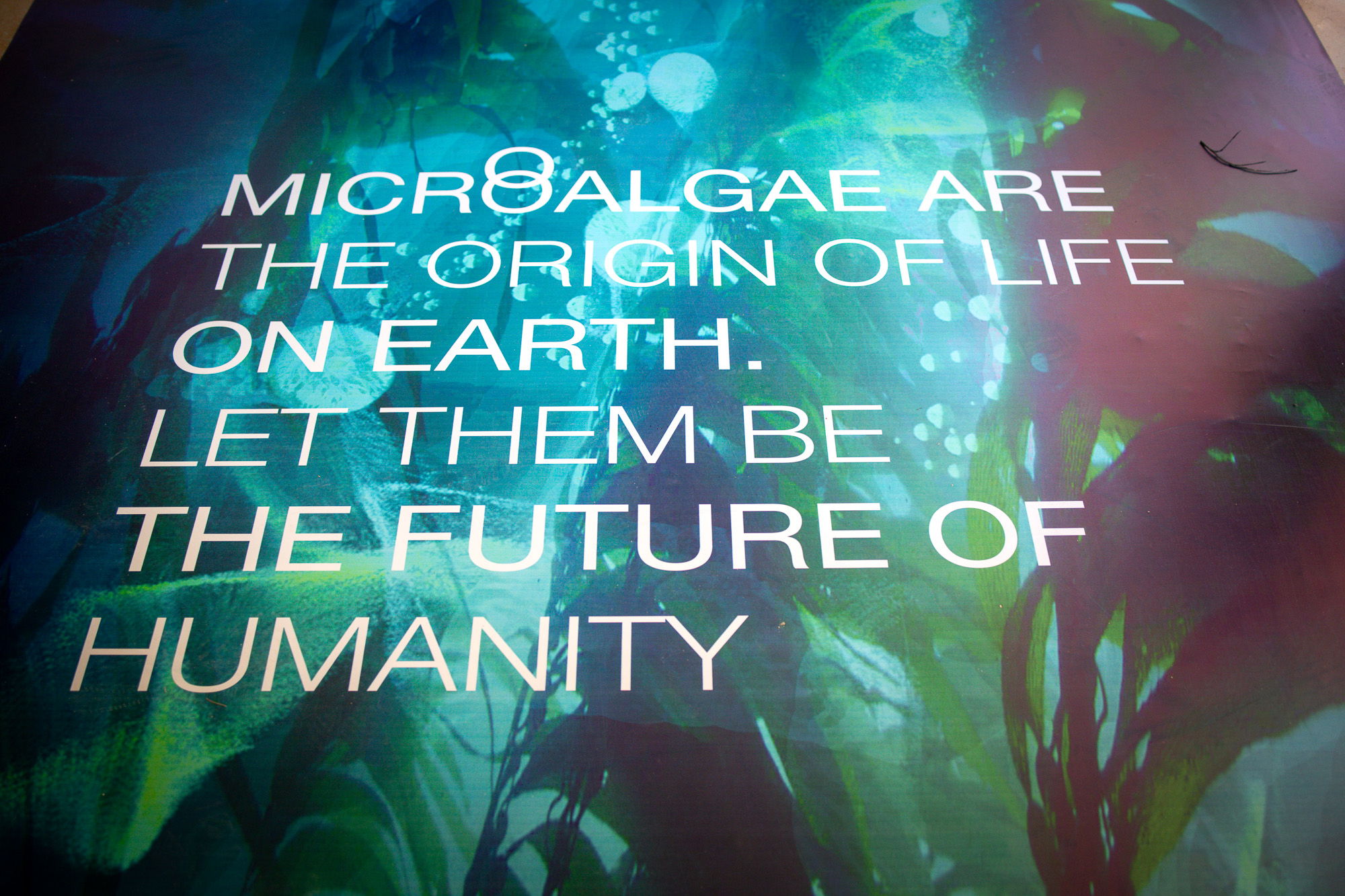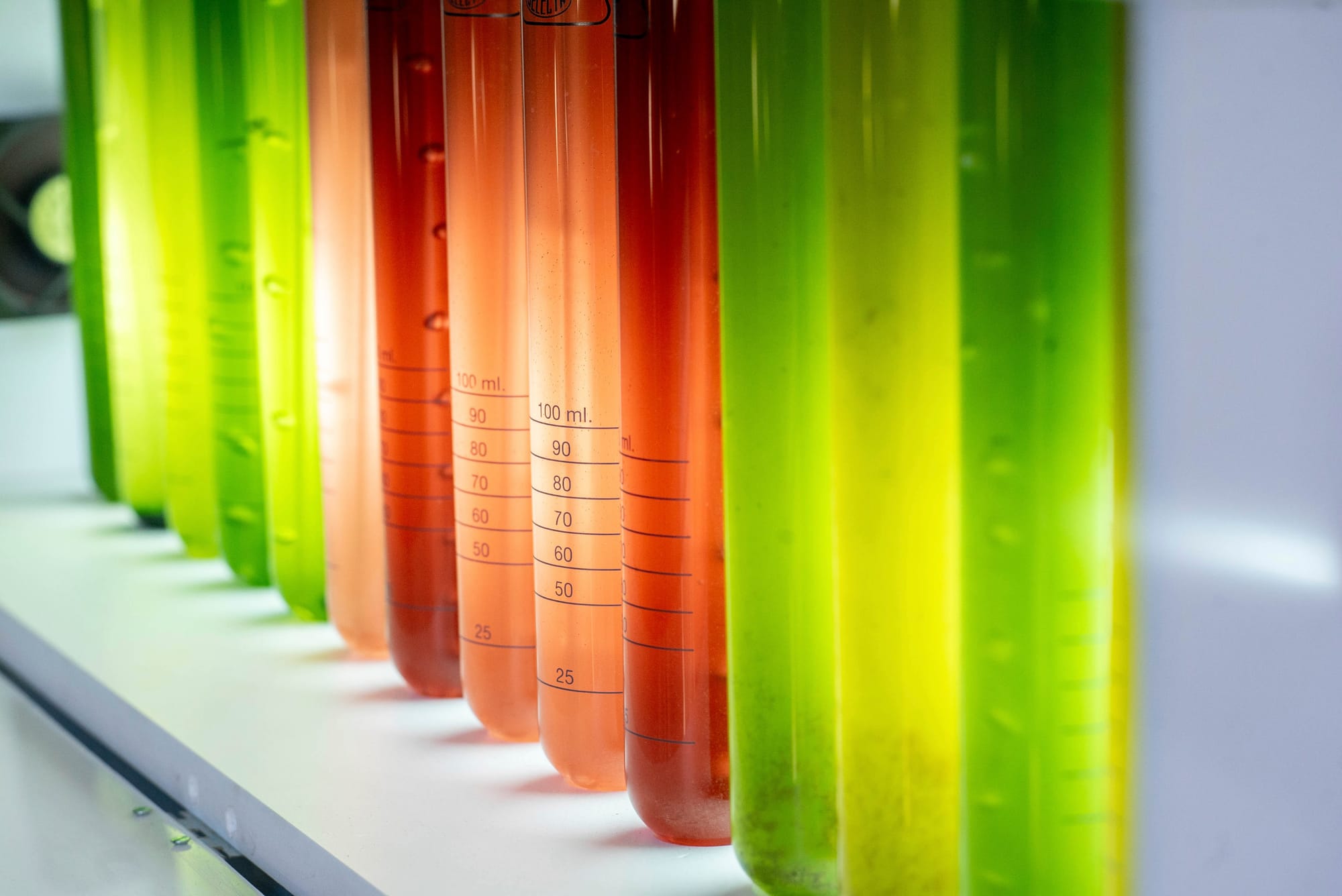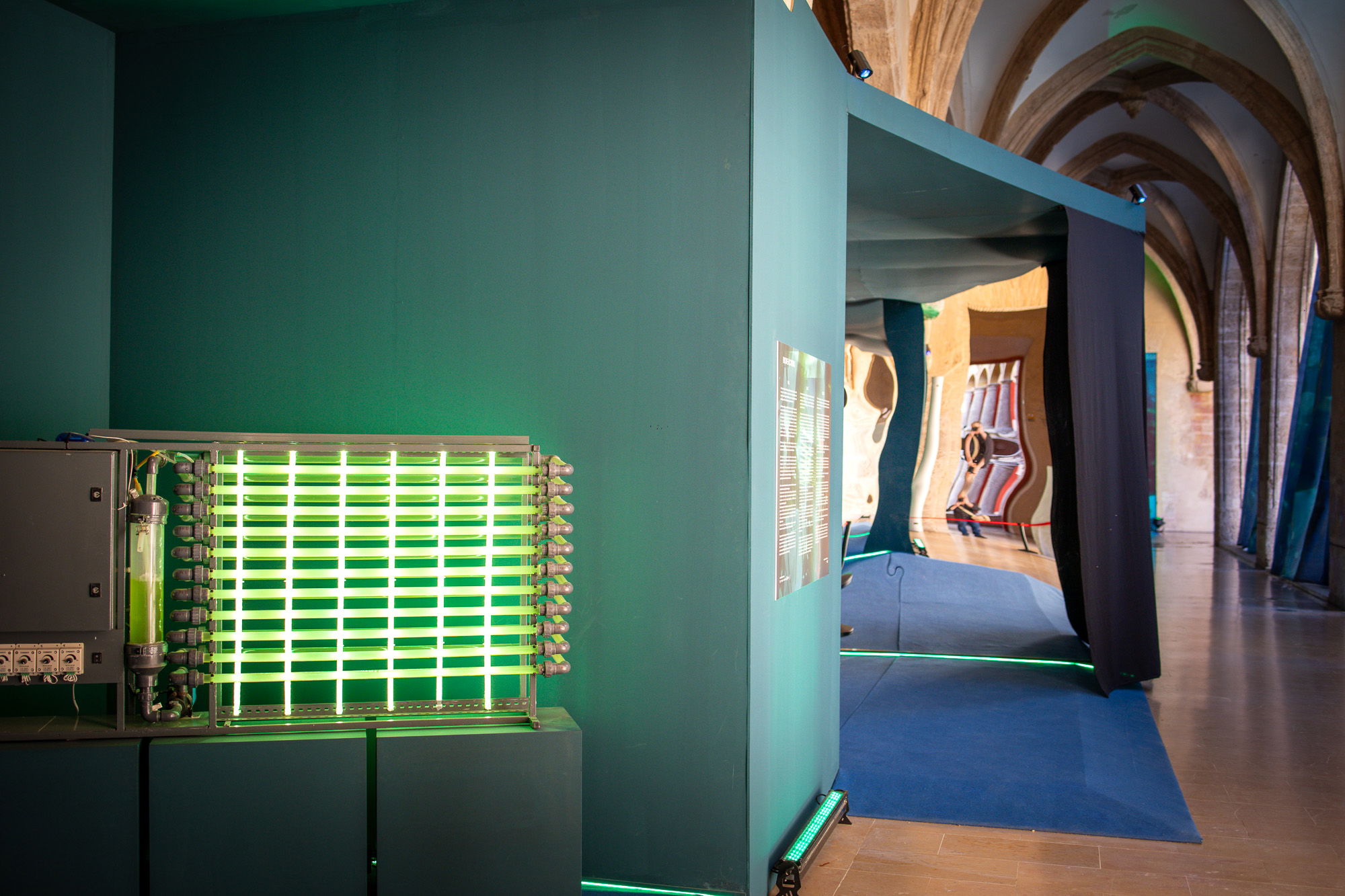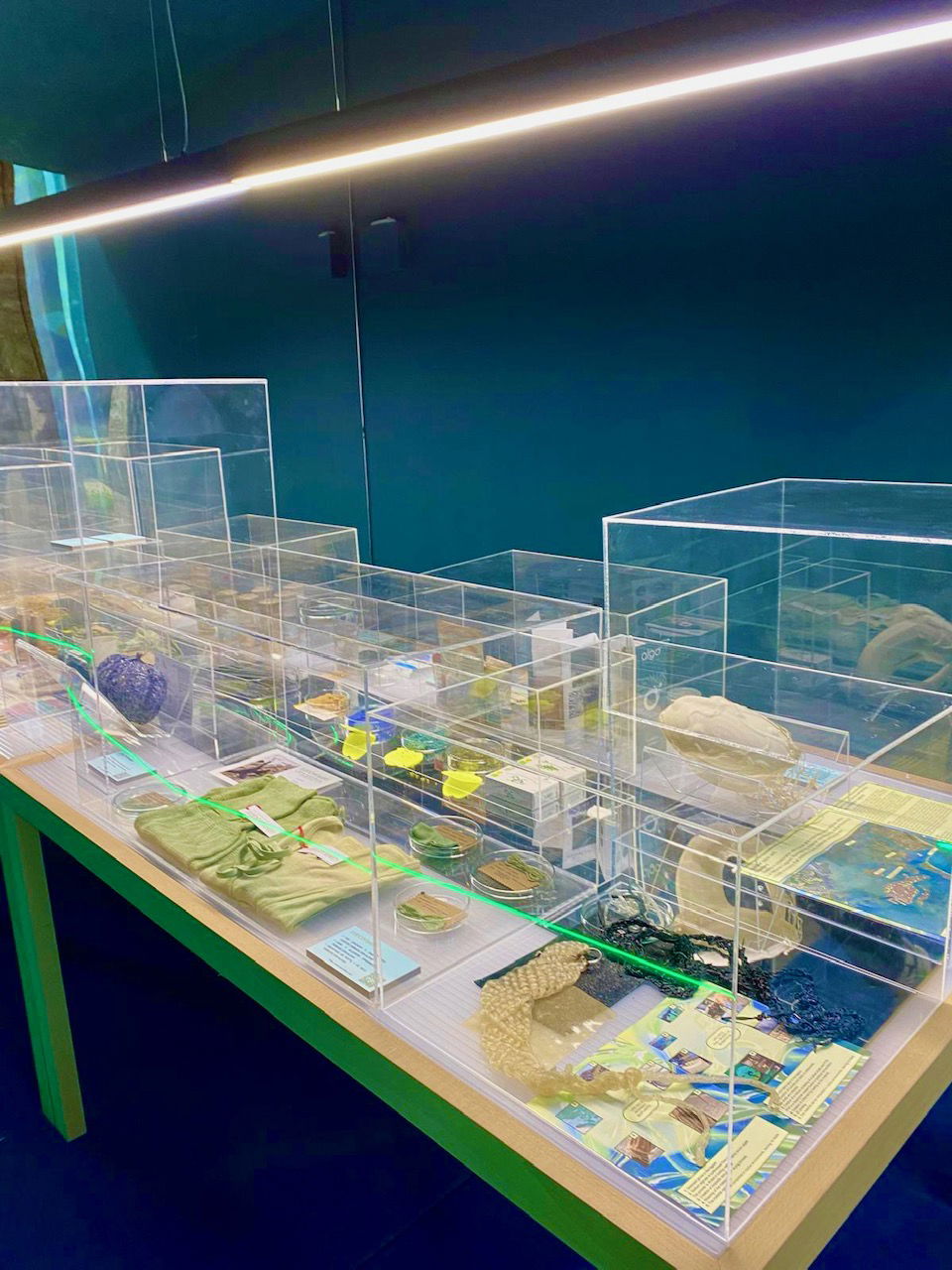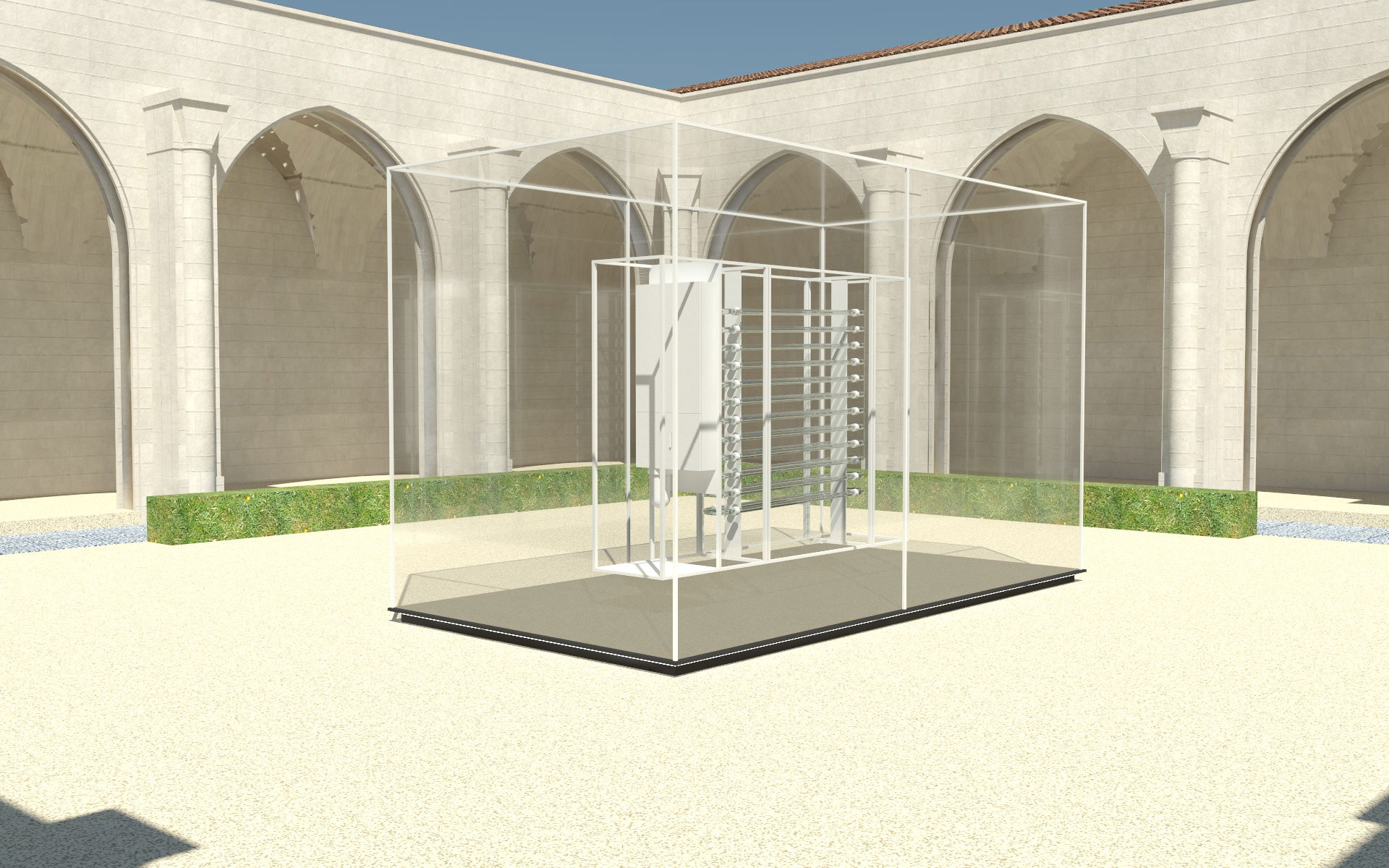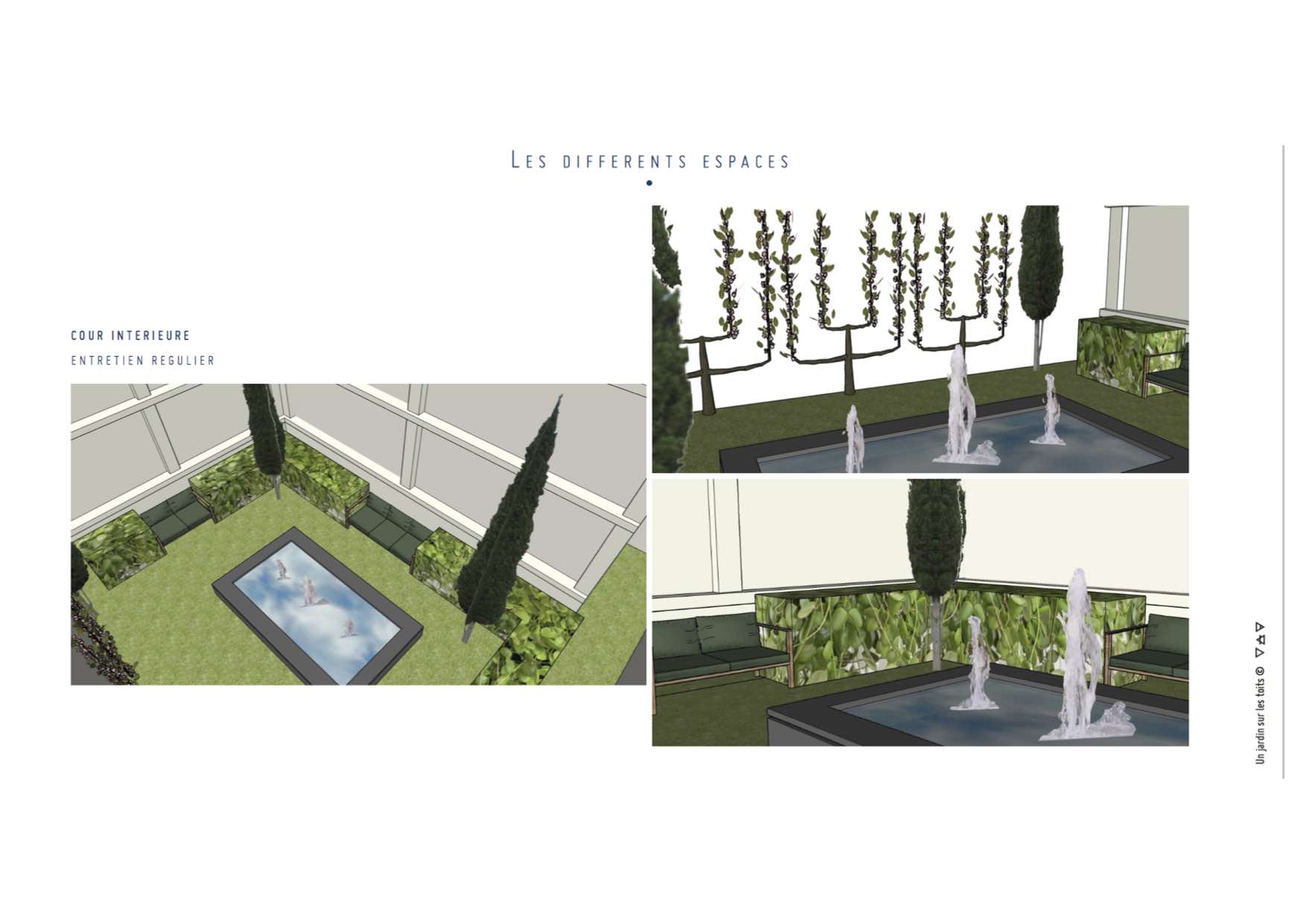L.A.B
UN JARDIN SUR LES TOITS
natural ressources and conscience
ABOUT
Our vocation is threefold:
- Research in the micro-algae sector, (for this we are multiplying collaborations with various international universities).
- Propose solutions to support companies towards net zero emissions while helping them find the best carbon offset solutions.
- Propose urban solutions (such as the establishment of micro-algae farms on high-density city roofs) in order to reduce pollution and more particularly air pollution.
We challenged ourselves to improve air quality through a series of innovative proposals related to botany and more particularly micro-algae by relying on all technical innovations.
The establishment of algae in urban areas was born from our desire to restore the major role of Nature on the environment and well-being.
Our priority is to study the mechanism of botany in a polluted environment and to provide concrete solutions to improve health by improving air quality.
The benefits of using micro-algae are now established and certainly confirmed: massive absorption of CO2 and fine particles, combined with the reconstitution of the ecological network.
Driven by the desire to create a real synergy between the various players in the field, exchanges between researchers are scheduled and educational tools developed.
This dream, which is becoming a reality day after day, was born from the passion of the agency “Un Jardin Sur Les Toits” for plants and more generally for micro-algae.
“Un Jardin Sur Les Toits“ agency combines nature, high tech, blue tech and clean tech.
Also specialized in the blockchain technology that we use on a daily basis, we help companies calculate the carbon impact of its use, of its ecosystems or products: fungible or non-fungible token, NFT and NFC and offer the most appropriate carbon offsets through micro-algae.
Scientific Aromatherapy
in order to bring an olistic dimension to all our projects and having the chance to collaborate with a specialist in scientific aromatherapy, we always combine it with olfactory aromatherapy in order to create a global immersive experience.
THE PRECIOUS ENVIRONMENTAL AMENITY
LAUREAT "INVENTONS LA MÉTROPOLE DU GRAND PARIS"
The air bubble
Located near the future station of the Grand Paris Express Nanterre La Boule (line 15 West) and carried by OGIC, the project Bubble Air aims to constitute a new entrance to the historic center of Nanterre in support of a building on the Place de la Boule, with a waterfall plant.
Designed by Brenac & Gonzales and Caractère spécial / Mathieu Poitevin Architects, Un Jardin Sur Les Toits is in charge of developing well-being for users, as well as the development of a Micro Algae Farm, a garden of Medicinal plants, an Aromatherapy program and, more generally, all botanical innovations.
IMPACT
THE AIR WE BREATHE
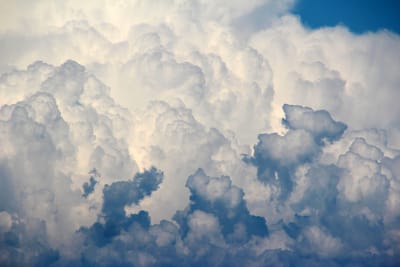
TECHNICAL SCHEME
The primordial atmosphere
Today, our atmosphere is composed of about 21% of oxygen, 78% of nitrogen, and 1% of small quantities of various gases: argon, neon, hydrogen, etc. But it has not always been so! It is estimated that Earth's primordial atmosphere - about 4.5 billion years ago - was mostly composed of hydrogen, nitrogen, carbon dioxide (CO2), ammonia (NH3) and methane (CH4). No oxygen, therefore! Or in very small quantities, of the order of only 0.0001%.
Therefore, we are talking about the absence of O2 gas , at that time. Paradoxically, the oxygen atoms were all there, and they were even among the most abundant elements on earth. But for the most part they were linked to carbon to form CO2 or trapped in rocks of the crust and mantle.
All this changed with the appearance of life about 3.5 billion years ago. A key element of life as we know it, is the ability to produce organic carbon molecules (such as carbohydrates, proteins or lipids), which serve as sources of energy. To make them, living organisms have to find carbon. The first bacteria found their carbon by picking up what came within their reach as nutrients (humans do the same). But about 2.7 billion years ago, a new type of bacteria appeared: cyanobacteria.
Cyanobacteria, which make up a good part of phytoplankton, contribute significantly to the surface fixation of oceans, atmospheric carbon dioxide (CO2). This role is of major importance today because of the increased production of this greenhouse gas by human activities.
As an essential link in oceanic food chain, they contribute greatly to the transformation of CO2 into carbon (the organic pump) and its storage in deep ocean sediments (carbon sinks), in reserve for the future needs of the planet.
Air Composition
Dioxygen, O2: 20.9476%
Nitrogen, N2: 78.084%
Argon, Ar: 0.934%
Carbon dioxide, CO2: 0.0314%
Hydrogen, H2: 0.000 05%
Neon, Ne: 0.001 818%
Helium, He: 0.000 524%
Krypton, Kr: 0, 000 114%
Xenon, Xe: 0.000 008 7%
The measurement of oxygen content in inhaled air is fundamental to health, (as well as we measure the various primary pollutants: oxides of carbon, sulfur, nitrogen, VOCs, PM10 and PM2.5 particles , metals or light hydrocarbons and ozone), the constant must be 21%.
ATMOSPHERIC OXYGEN
ATMOSPHERIC OXYGEN
Photosynthesis, respiration and dissolution in seawater act simultaneously and vary the concentration of oxygen in the atmosphere. These variations were measured by Keeling and Shertz (1992) in three places on the planet: Alaska, California and Tasmania. In the first two, both located in the northern hemisphere, there is a maximum of atmospheric oxygen in summer and a minimum in winter. The summer maximum is mainly due to the photosynthesis on the land surface that characterize this hemisphere. In winter, breathing and dissolving in the colder sea water combine to give rise to a minimum. Between maximum and minimum, the difference is approximately 26 ppm (parts per million) in Alaska, and 20 ppm in California. This difference is smaller in Tasmania (18 ppm), the southern hemisphere being mainly occupied by the oceans and terrestrial photosynthesis only plays a small role. These seasonal variations are very small compared to the oxygen concentration of about 200,000 ppm. The highest, that observed in Alaska, represents only 0.013%. Even a small change in the oceans balance , or global photosynthesis (even in the case of the Amazon, the so-called "lung of the planet"), could threaten the quality of the atmosphere in the medium term.
Human disturbance
For more than a century, man has been meeting his energy needs by burning coal and hydrocarbons from photosynthesis of past geological eras. This combustion consumes oxygen. Similarly, the increase in the world's population has led to the clearing of forests and replacing them with crops. This practice also results in oxygen consumption. On one hand, the biomass that constitutes the forest, very high, is largely transformed into carbon dioxide. On the other hand, agricultural practices generate an impoverishment of the soil by degradation of the organic material they contain (humus). This degradation is caused by organisms that breathe and therefore consume oxygen. The corresponding decreases are in total at the rate of about 4 ppm / year or about 0.002% of the oxygen content of the atmosphere.
Again, there are reasons to fear a lack in the decades to come, as the emissions of carbon dioxide by the man continue to increase every year .
Oxygen tends to associate with other chemicals to oxidize (burn). Thus, stocks of carbon or organic matter that do not currently participate in the living matter cycle could "go up in smoke" by incorporating oxygen. Soil organic matter is an example as we saw above when forests are cultivated. Oxidizable carbon stocks are available in the Geneva based 5th IPCC ( Intergovernmental Panel on Climate Change )report. Knowing that an oxidized carbon atom in a carbon dioxide molecule consumes an oxygen molecule, a rapid calculation gives, in case of rapid global oxidation of these stocks, the following orders of magnitude (percentages of decrease in atmospheric oxygen):
oxidation of hydrocarbons (gas) - 0,19% oxidation of hydrocarbons (petroleum) - 0,07% oxidation of coal - 0,16% oxidation of organic matter of soils - 0,64% oxidation of permafrost - 0,55%
Oil, gas and hydrocarbons, if they pose a threat to the climate, can therefore cause, in the case of intensive mining, a decrease in the oxygen concentration of the atmosphere.
According to a study of the INRS "National institute of research and security" on Confined Spaces, the measurement in oxygen content in a confined or polluted space must be controlled: Measure Oxygen Content Together, the oxygen content of the ambient atmosphere will be monitored using a portable oxygen meter. If the oxygen content is less than 19%, penetration should only be carried out with respiratory protective equipment. It should be noted that any measured oxygen concentration below 20.5% already reflects
an anomaly in the atmosphere of the confined space (oxygen consumption or accumulation of another gas).
MICRO-ALGAE STUDIES + DEVELOPMENTS
IMPACT OF MICROALGAE ON AIR QUALITY
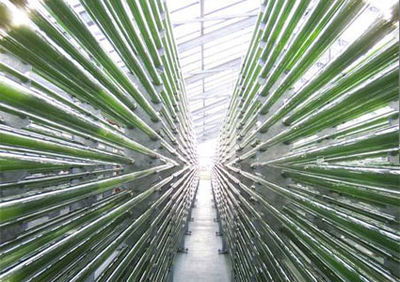
Spirulina is a great provider of oxygen. Forests play an important role in storing carbon dioxide (CO2). Trees are the best plants for fixing carbon: from 1 to 4 tons per year and per hectare. But Spirulina is even more effective: in the California desert, it can fix up to 6.3 tonnes of carbon per hectare / year; at the same time it will produce 16.8 tons of oxygen (ha / year).
Spirulina is the only fixed nitrogen .....
Purification system: François Haldermann presented at the symposium of Mialet on spirulina (in June 2012), his aeration system made in Ecuador to digest organic matter accumulated in culture media. We go from a BOD (biological oxygen demand) of 15mg to a BOD of 8mg. This aeration system allows a total recycling of the culture medium, while maintaining high productivity basins.
Microalgae and heavy metals
Microalgae culture in a continuous photobioreactor
These studies confirm the fixation of dissolved CO2 in the form of organic matter via photosynthesis. The different carbon species, which are formed during the dissolution of CO2 in the aquatic environment, and the formation of O2 depend on the temperature and pH.
It is clear that the nitrogen concentration acts directly on the formation of biomass thus defining the amount of protein and chlorophyll per cell. Phosphorus fixed by algae is also necessary for the transport of photons during photosynthesis.
Carbon metabolism and the assimilation of nitrogen and phosphorus are therefore directly influenced by enzymatic regulations associated with heavy metals.
Since carbonic anhydrase is a zinc-containing metalloenzyme, a decrease in its activity in response to zinc deficiency may affect the entire
carbon metabolism of the cell and therefore the production of intracellular metabolites. often the functioning of the photosynthetic apparatus, for example a too low concentration of sulphide will reduce the flow of electrons at the level of the photosynthetic apparatus (Rochaix, 2001) and a decrease in the iron concentration will induce a decrease in the constituents of the photosynthetic apparatus (PSI, PSII, cytochromes) because they have many co-factors containing iron (Terauchi et al., 2010). Similarly, since copper is present in many enzymes in the photosynthetic apparatus, its limitation impacts photosynthetic metabolism (Hill et al., 1996, Rochaix, 2001). But other intracellular processes may be involved; this is the case of nitrogen metabolism, the assimilation of which in the cell is reduced during a molybdenum deficiency in the medium (Glass et al., 2009). An increase of these elements in the medium will, conversely, have a positive impact on the cells. This is the case of magnesium or iron which allow the increase of the cellular concentration when they are in higher concentration in the medium (Mandalam).
Conclusion
In conclusion we are able to say that the Cyanobacteria "Spirulina" feed on CO2 but also fix nitrogen and heavy metals such as lead, arsenic and cadmium while restoring O2 (dioxygen) in large quantity. Spirulina is therefore a most effective air purifier.
Although it is mostly used today for its biomass and the production of clean energy, several companies and research centers such as NASA, ESA or Suez, already use it for its depolluting properties.
KEY FIGURES
Organic OXYGEN & MICRO-ALGAE FARM
Un Jardin sur les toits, presents the first Organic Oxygen Farm based on micro-algae production by biochemical conversion of CO2 to O2 in photobioreactors.
- Plan area 10 000m2 (up to 500 000m2) + Laboratory infrastructure/facility
The plant develops up to 2.6 meters height. In this configuration it is composed of 22 modules. The process is based on the absorption of CO2 by selected algal strains prepared on a laboratory scale and subsequently inoculated into the growth volume in the plant on an industrial scale.
Downstream phase relating to the extraction of Molecules with high added value and Oxygen by means of a patented generator.
MICRO-ALGAE & NUTRITION
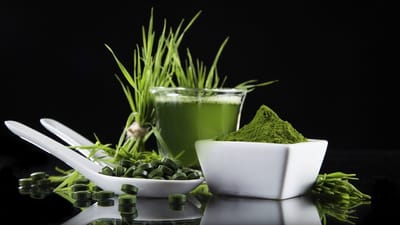

We will only talk in this paragraph about the best known micro-algae: Spirulina considered by the WHO as the super food of the 21st century for humanity.
Spiruline is a cyanobacteria, or blue-green micro-algae, that appeared on Earth 3.5 billion years ago, particularly recognizable for its 0.2-0.5 mm long spiral shape.
These single-celled organisms, capable of photosynthesis, lie at the root of the development of all terrestrial plants and led to emergence of aerobic living beings.
Found on all continents besides Antartica, bue-green micro-algae comprise 1,500 different species, of which 36 are edible.
Spiruline is recognized as one of the richest foods on the planet. Its many benefits are linked to its extraordinary composition.
Spiruline is mostly composed of proteins, containing all of the amino acids that are essential to our body.
Spirulina is contains Minerals, vitamins, and pigments
The most relevance of inorganic micronutrients in Spirulina is Potassium, magnesium, calcium, zinc, phosphorous and iron. They are important for nutrition human body. Iron can help to improve anaemia and hypertensive disorders. Phosphorus and calcium are comparable to those in milk. The proportion (Ca:P) of this micronutrient is compatible with the bone health to reduce decalcification. The iron, calcium and phosphorous content of Spirulina are 1.7, 15, and 10 mg, respectively.
Vitamins, Minerals and pigments composition of Spirulina (per 1g sample) :
Vitamins composition
Biotin - 0.55 ug
Folic Acid - 0.71 ug
Pantothenic Acid - 2 ug
Cyanocobalamin (Vitamin B12 )- 3.6ug
Pyridoxine (Vitamin B6) - 8 ug
Thiamine (Vitamin B1) - 48 ug
riboflavin (Vitamin B2) - 55 ug
Niacin (Vitamin B3) - 0.15 mg
Tocopherol (Vitamin E) - 0.41 mg
Inositol Acid - 0.7 mg
Beta-carotene (pro-vitamin A) - 5.8 mg
Bioflavonoids - 10 mg
Minerals composition
Potassium (K) - 16 mg
Calcium (Ca) - 15 mg
Phosphorus (P) - 10 mg
Manganese (Mn) - 3 mg
Zinc (Zn) - 70 ug
Magnesium (Mg) - 3.7 mg
Sodium (Na) - 2.5 mg
Pigments
Phycocyanin - 180 mg
Chlorophyll - 11 mg
Total Carotenoids - 6mg
Iron (Fe) - 1.7 mg
The dried powder Spirulina contains some of the vitamins like Thiamine, riboflavin, Niacin, Pyridoxine, Cyanocobalamin, and Tocopherol. One of the important and complex vitamins is cobalamin (vitamin B12). It is very important because vitamin B12 is only contained in animal origin foods. according to Table 1, the cyanocobalamin (B12) content of Spirulina about 3.6 g. The Spirulina is also known as a good beta-carotene source because it is containing about 5.8 mg g-1. beta-carotene will be absorbed to bio-transformed into vitamin A. Human body requirement of vitamin an about 1 mg/day, therefore 1-2 g of Spirulina will be sufficient for this need.
The phycocyanin, chlorophyll, and carotenoid are an important group of pigment found in Spirulina. Carotenoid is played as lipophilic antioxidants and responsible as an anticancer agent. The pigment component of Spirulina showed in Table 1. The contains both of the phycocyanin, chlorophyll, and carotenoid were 180.11 and 6 mg, respectively.
The Spirulina can be categorized as a superfood, because of its high nutrient content. Spirulina contains nutrients like protein, vitamins, essential fatty acids, amino acids, minerals, and phytonutrients. The high phytonutrient content of Spirulina can be considered an alternative food for vitamin supplements.
references : Deasy Liestianty et al 2019 IOP Conf. Ser.: Mater. Sci. Eng. 509 012031
PROJECTS
THE SECRET LIFE OF MICRO-ALGAE EXHIBITION
THE SECRET LIFE OF MICRO-ALGAE
V.O.F
Virtual Oxygen Farm
First 3D - 4.0 - AI assisted virtual photobioreactor in the world
V.O.F is the first virtual micro-algae photobioreactor completely autonomous with the ability to calculate and offset in real time the CO2 emitted by the virtual matrix in order to convert it into oxygen in the real world.- Using the blockchain technology to record its results, it works in total transparency and without the possibility of being able to undergo any alteration in its calculations.- V.O.F is the missing link between the virtual and the real world.- By using micro-algae as partners the V.O.F have the ability to fix 12 times more CO2 than any terrestrial plants.Micro-algae have an incredible capacity for renewal (only few hours by cycle) and do not mobilize any floor space and only very few resources.By doing so, they actively contribute to the reduction of GHG and are an essential link in climate regulation, air and water purification.Symbiosis between the living (micro-algae being the first micro-organisms to appear on earth more than 3 billion years ago) and AI gave birth to the V.O.F the first virtual CO2/O2 AI assisted converter.
MIROMESNIL pollution analysis laboratory
33 MIROMESNIL PARIS FRANCE ALLIANZ REAL ESTATE FRANCE
Complete redevelopment of an 1930 art-deco building roof-top garden with a pollution analysis laboratory.
Learn More29,CHATEAUDUN MICRO-ALGAE greenhouseS

THE LAB - A MICRO-ALGAE & GREEN RESOURCES RESEARCH CENTER
POLLUTIONS & NUISANCES

Technologies greatly help also for water treatment. The latest generation pools and spas, instead of using aggressive chlorine, use natural salt electrolysis to purify water and to disinfect from bacteria and fungi. They also employ ultraviolet light to dechlorinate water so that the disinfected water is not irritant for skin and mucosa and not aggressive for bath suits. Used in shower heads, red tourmaline ceramics invigorate the bath with a Spa effect, projecting far infrared waves; germanium black ceramics produces negative ions and has a cleaning action on the skin by neutralizing dirt, grease and odors, and greatly reduces the use of soap and shampoo; antibacterial white ceramics prevent the formation of pathogens in stagnant water in the shower. Hydrogenated water, according to several studies, works as an antioxidant, neutralizing free radicals and fighting against degenerative processes, skin ageing, wrinkles and other types of oxidative stresses. Water rich in molecular hydrogen, obtained by electrolysis, is used since more than ten years in Japan for multiple purposes like diabetes reduction, elimination of lactic acid for sportsmen and as antiaging.
New composite materials with air traps and 3D structures are used to decrease noises; smart textiles insulate from electromagnetic fields; catalytic fabrics and nanotechnologies are used to eliminate odours, while aromas and essential oils diffusers are used to create stimulating and fortifying, or relaxing and soothing environments; essential oils also offer antibacterial properties which are already greatly used in hospitals, nurseries, veterinary clinics and pet shops.
urban solutions
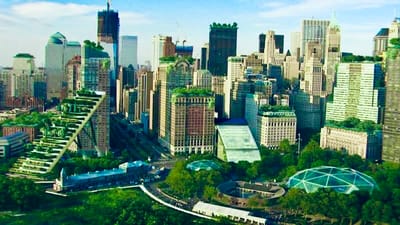
In order to accomplish this target we use micro-algae, greentech, ecotech, bluetech and the blockchain technology.
support towards net zero emissions
As the physical impact of climate change becomes more evident and public concern and activism escalate, businesses across all sectors face a growing range of climate-related risks, such as litigation and transition threats.
As these risks escalate, they can quickly devalue or immobilize a company's physical, human and intangible assets, creating the need for a resilient and sustainable business model. ( University of Cambridge)
The 2015 Cope 21 Paris Agreements adopted by 196 of the parties present set clear targets to limit global warming to 1.5 degrees Celsius above pre-industrial levels.
By committing to reduce their greenhouse gas emissions by 55% by 2030 to achieve carbon neutrality by 2050, the signatory members have affirmed their ambition for a better world.
Despite this, a 2018 IPCC report shows that if emissions continued to be emitted at the current rate, the planet would expect 1.5 degrees Celsius by 2040.
After a lackluster Cope 27, it is important for all players around the world to finally take into consideration the capital issues that will make it possible to reduce global warming as much as possible.
In order to support companies towards net zero emissions, it is essential to have
a comprehensive understanding of how best to mitigate the business, social and environmental risks of climate change and oversee a low-carbon transition.
A company with a resilient low-emission business model will improve the potential longevity of your organization and unlock new opportunities for growth and innovation, now and in the future.
For this we propose a balance sheet in three stages:
- A calculation of the carbon footprint.
- A UN labeling of our results.
- Solutions to bring companies to net zero emissions or carbon offsetting through the support of micro-algae farms.

THE LAB
The role of micro-algae in sustainable development, as well as their ability to massively fix CO2 and produce O2, will also be studied and monitored.
Temperatures, energy, hydrology at different levels, PH level etc. will be constantly controlled.
This research center will exchange with international researchers and university staffs specialized in micro-algae, meteorology and entomology. Experts will also be invited to visit the urban physic micro-algae farm and to study the impacts on site.
The study of the impact of micro-algae on air and water pollution and hydrology is a new discipline.
This multi-disciplinary activity seeks to provide key notions about the role of micro-algae and to give contextual results.
The term "micro-algae", covers a wide diversity of species with different physical and physiological properties: resistance to drought and evapotranspiration, colour and albedo, density , etc. Local meteorological conditions (sun, wind,and hydrology) vary significantly in the urban environment. Management also plays a major role which is complex to standardise.
Always on the lookout for new molecules that can play a role in sectors such as pharmaceutical, beauty, the food industry, agriculture, energy or the conquest of space, the Lab is a key element in the success of any project dealing with micro-algae.The impact of micro-algae in a polluted environment is no longer questioned, but adaptability remains a question which always requires a great deal of research.
Ecosystemic services are fundamental to the urban environment. Major cities and industries must confront demanding environmental objectives which may sometimes seem contradictory, such as densification to limit urban spread, biodiversity maintenance, anticipating and limiting climate change, the reduction of greenhouse gases and providing a healthy and agreeable environment for the inhabitants. These issues must be taken into account at every level of urban spatial intervention and be monitored over time. Concretely, this requires constant questioning about the role that micro-algae farms have to play in urban setting.
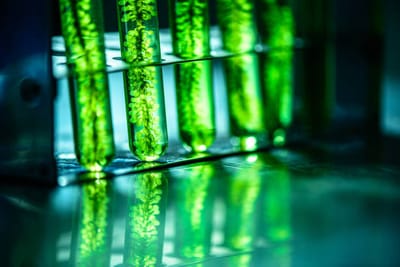
HEALING WITH NATURE'S POWER
SCIENTIFIC AROMATHERAPY
SCIENTIFIC AROMATHERAPY
He is deeply convinced that the active properties and the helming power that lies in the molecules of medicinal plants contribute to improve the well being of the users.
Aromatherapy implies the use of aromatic compounds extracted from plants in the form of essentials oils for medical and healing purposes as a complementary therapy or an alternative medicine. this differentiates it from phytotherapy which make use of all the elements of a plant : seeds, flowers, fruits ,roots .
Originally practiced according to a traditional approach, as a branch of phytotherapy it came s together along the naturopathy disciplines and was classified as non-conventional medicine. Increasingly studied by scientists, especially in the contest of pharmacognosy, which provides evidence for the properties os essentials oils,it can now be practiced according to the principles of evidence-based medicine by health professionals.
The term aromatherapy was used for the first time for the first time by the chemist René Maurice Gattefossé in 1935.
It comes from the ancient greek: aroma ( aroma) and therapeia ( therapy).

THE ORIGINS
In the history of medicine and at least until the sixteen century, the history of aromatherapy is largely blended with phytotherapy.
If we find the traces of distillation extractions methods, in China and India, ( ayus-veda) back severals millennials , it is in Egypt that their use has first been proven.In ancient Greece, the writing of Dioscorides refers to the use of aromatic extracts. The Romans also used them in the form of oily ointments.
The Persian alchemist Jabir Ibn Hayman ( GEBER) was credited with inventing the alambic and allowing the production of the first distillation quintessence in the 8th century A.D. Extraction processes subsequently improved with pharmacopoeias using them toward the sixteen century. it was only in the 19th century that the active principles of odoriferous molecules began to be isolated and classified, allowing their specific use.
THE FRENCH SCHOOL
In 1910, the chemist René-Maurice Gattefossé ( 1881-1950) who researched perfumery, burned his hands during a laboratory explosion . Very badly burned, and treated according to the means of contemporary medicine, he was rapidly affected with gas gangrene. As a last resort, removing his bandage, he applied lavender oil to his infected wounds. The results were astonishing and confirmed his intuition: the essence of lavender possessed real antiseptic and cicatrizing properties. From then on ,he devoted most of his research to the properties of essential oils. In the 1960's Dr. Valnet ( 1920-1995) resumed the work of Gattefossé and published
in 1964 the reference book " Aromatherapy: treatment of diseases by plant essences".
Subsequently, Pierre Franchomme, with the notion of scientific chemotype, helped to improve the identification of active ingredients in the extracts used. They are both considered the fathers of the modern scientific aromatherapy.
At the end of the 20th century, as with all pharmacognosy, scientific aromatherapy benefited from the advances in analytical methods, in particular chromatography . The precise distinction of aromatic compounds allowed medicine to better understand their mechanism of action, and to refine their prescription.
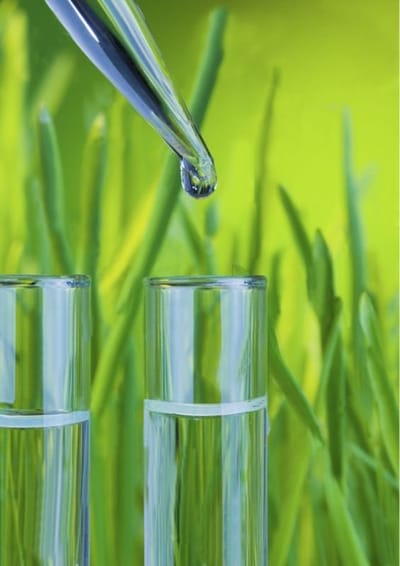
TEAM
EXTERNAL COLLABORATOR
CONTACT
ENVIRONMENTAL REGULATIONS
HQE
In France, we work on buildings certified HQE® (High Environmental Quality), H & E (Habitat & Environment), BBC effinergie (Low Consumption Building), Passivhaus and BEPOS (Positive Energy Building). At the international level, we work with BREEAM and LEED certification.
Learn MoreBREEAM
Created in the 1990s in the United Kingdom, it is the oldest repository in terms of sustainable construction. With more than 250,000 certified buildings worldwide, BREEAM now has international visibility.
Learn MoreLEED®
LEED® certification, Leadership in Energy and Environmental Design, is an environmental certification for buildings initiated in the United States in the year 2000 by the US Green Building Council®. More than 100,000 LEED projects are certified or currently being certified in more than 120 countries. Each level requires a minimum of points:
Learn MoreRT2012 – EFFINERGIE
The "Grenelle Environnement 2012" thermal regulation, known as RT 2012, is a regulatory tool for new residential and tertiary buildings. It aims to improve energy consumption by setting a maximum limit.
Learn MoreTHE WELL BUILDING STANDARD®
The WELL Building Standard (WELL) focuses on the people in the building. Over the last decade, green building standards and standard-setting organizations have made significant strides towards the market transformation of the building industry, resulting in a rapid expansion of green buildings and environmentally conscious building practices throughout the world.
Learn MoreNorme ISO 9001
Definition: ISO 9001 ISO 9001 is defined as the international standard that specifies requirements for a quality management system (QMS). Organizations use the standard to demonstrate the ability to consistently provide products and services that meet customer and regulatory requirements. It is the most popular standard in the ISO 9000 series and the only standard in the series to which organizations can certify.
Learn MoreISO 14001
What does it do and who is it for? ISO 14001 sets out the criteria for an environmental management system and can be certified to. It maps out a framework that a company or organization can follow to set up an effective environmental management system.
Learn MoreOrganic Certification
Organic certification is a certification process for producers of organic food and other organic agricultural products, in the European Union more commonly known as ecological or biological products.[1] In general, any business directly involved in food production can be certified, including seed suppliers, farmers, food processors, retailers and restaurants. A lesser known counterpart is certification for organic textiles (or organic clothing) that includes certification of textile products made from organically grown fibres.
Learn MoreCOLLABORATIONS


